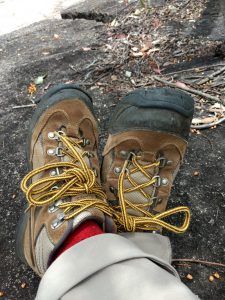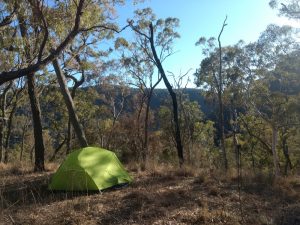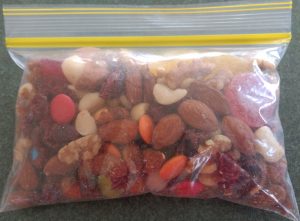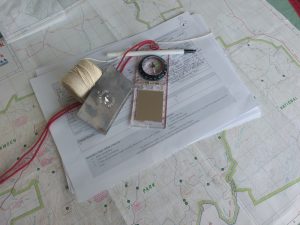I meet many people who would like to take themselves or their family on outdoor adventures, but they’re not sure how to get started bushwalking. In this article, I’ll outline some simple steps you can take to get started, stay safe, and have loads of fun! Keep your eyes open for a whole series of articles on places you can bushwalk across South East Queensland and beyond.
What equipment do I need to go for a bushwalk?
The basic equipment is really quite simple:
- a comfortable and sturdy pair of covered shoes
- a drink bottle,
- a hat, and
- some sun protection such as sunscreen and sun-safe clothes
- basic first aid and medical supplies for yourself or your group such as an asthma puffer and snake bandage – I slip a snake bandage into my pocket or backpack even on short walks
If you’re bushwalking in cold or alpine areas, you’ll also need:
- warm layers of clothing eg jacket, beanie.
And if the weather is damp, you might like to have:
- a rain coat or poncho
What else do I need to think about for longer or more challenging walks?
As you become more experienced, you might like to go on longer or more challenging bushwalks, so it’s important to have:
- well-fitting shoes and socks suitable for the terrain and the climate
- a small backpack that can hold all the gear you’ll need for an awesome day out – snacks, water, extra layers of clothing, raincoat, maps, emergency devices, and a camera,
- some people like to wear gaiters to protect against snake bites and prickly plants
What about overnight hikes and camps?
If you plan on a multi-day bushwalk you’ll also need to have:
- a well fitting backpack large enough to hold your gear, especially if you plan to be self-sufficient,
- a shelter such as a tent,
- food for the duration of your expedition
- enough water plus a bit extra to get you to your next water supply – this includes water for drinking, cooking and cleaning,
- a water purification system if you plan to collect water from untreated water supplies,
- a sleeping mat,
- sleeping bag,
- toiletry items,
- a trowel and toilet paper,
- extra clothes to sleep in or if you want a clean set of clothes for your second day,
- a stove and cooking equipment,
- maps and navigation equipment such as a compass and / GPS, and
- emergency communication equipment such as an emergency beacon, EPIRB, or GPS communication
We’ll cover equipment for overnight hikes in more detail in a future article.
How much water will I need?
The amount of water you need to take depends on lots of things including how far and how long you’ll be bushwalking as well as the temperature and humidity, whether there is drinking water available along the way, how strenuous your walk is, and how much you as an individual need to drink. A very rough guide is usually a minimum of 2 litres per day, however I’d recommend more than that especially if the weather is hot, and just in case you stay out longer than planned. If you’re planning to cook, you’ll need extra as well.
How much food should I take on a bushwalk?
If you’re going for a short walk (less than an hour), you generally won’t need to take food.  However, I think every walk is much more fun when you stop for a little picnic along the way. Choose food that won’t easily spoil or be squashed. It also pays to think about how heavy your snacks are and take a bag or container to transport your scraps back home.
However, I think every walk is much more fun when you stop for a little picnic along the way. Choose food that won’t easily spoil or be squashed. It also pays to think about how heavy your snacks are and take a bag or container to transport your scraps back home.
Where can I go bushwalking?
Popular public walking spaces in Australia can be found in regional or council parks, state reserves and forestry, and in national parks. There also some privately owned land holdings that are open to the public. You can search the Internet for what’s available in your local area. Regional tourist information sites and centres also provide this information. Australian walking trails are often classified according to levels of difficulty from Class 1 to Class 5. This makes it easier for you to plan the right type of walk for your group.
In future articles I’ll share some of my favourite places with you.
How much does it cost to go bushwalking?
Most walking trails in Australia are free, however there are some parklands that require you to purchase a permit for vehicle entry (such as some national parks in some states). And you need to book ahead and pay an entry fee for some multi-day walks which assists with managing and maintaining the trails and surrounding environment.
Is it safe to go bushwalking alone?
Walking solo can be a great experience if you are properly prepared. I’d recommend:
- Tell someone where you are planning to go and when you expect to be back, and then make sure you let them know you’ve arrived home safely afterwards.
- Be extra careful about preparing and packing for your walk because you only have yourself to
 rely on.
rely on. - Take some extra water and food, as well as first aid supplies.
- Stick to trails that are within your level of expertise.
- Take a phone but don’t rely on having mobile coverage everywhere. (Remember you can use your phone’s GPS to help you work out where you are even if you don’t have phone coverage. The GPS function uses a satellite system not a mobile phone system.)
- Download navigation and emergency services apps and practise using them before you go! Some suggestions include:
- Orux Maps
- GPS to SMS
- Emergency+
How can I meet other people to bushwalk with?
Here are a few ways to meet other people who like to bushwalk:
- join a bushwalking club
- look on Facebook and MeetUp for bushwalking groups and activities
- find a professional guide who can lead you on an organised walk
- ask about walking groups and organised activities at tourist information centres and national parks offices
- say hello and strike up a conversation with other people you meet along the trails – you’ll be surprised how much information other people have!
So there you have it – a brief introduction on how to get started bushwalking. Join me for future articles where we’ll explore more details about the amazing places you can go no matter your level of fitness or experience. And send me a message if there’s a particular question or topic about bushwalking that you’d like answered.

Discovering mountain biking as life’s ultimate parallel universe in her middle age, Kathryn Walton shares information and reflections in ‘Daisy Spoke’ that inform, inspire and empower women to a healthy and active lifestyle.
